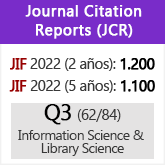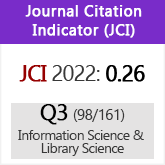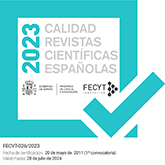Ranking de revistas científicas en Latinoamérica mediante el índice h: estudio de caso Colombia
DOI:
https://doi.org/10.3989/redc.2013.1.876Palabras clave:
Google Académico, índice h, Colombia, ranking, políticasResumen
El futuro de las revistas científicas en Latinoamérica es incierto. La incapacidad de calcular indicadores bibliométricos útiles para clasificarlas y homologarlas con cuartiles de referencia mundial reducen su visibilidad. Por ejemplo, las revistas colombianas clasificadas en la Base Bibliográfica Nacional Publindex (BBNP) bajo las categorías A1, A2, B y C, poseen baja indexación en bases de datos internacionales como Web of Science o Scopus, limitando la estimación de indicadores bibliométricos para su comparación a nivel internacional. Como estudio de caso se seleccionaron 211 revistas de la BBNP-2008, tomando artículos publicados entre 2003 y 2007. Utilizando Google Académico, el software Publish or Perish y la base de datos Scopus, se cuantificaron y compararon indicadores de productividad e impacto para construir un ranking local (Q1-Q4) y realizar una homologación internacional con Scimago Journal Rank (SJR). El índice h resultó el mejor indicador para generar un ranking basado en cuartiles (Q1-Q4) de 170 revistas colombianas, homologables con cuartiles de SJR. Se propone esta metodología para clasificar y homologar las revistas latinoamericanas no indexadas, como herramienta útil para editores, editoriales, empresas de información y tomadores de decisiones en políticas públicas de educación, ciencia y tecnología a nivel regional y mundial.
Descargas
Citas
Adams, J. (1998). Benchmarking international research. Nature, vol. 396 (6712), 615-618. http://dx.doi.org/10.1038/25219 PMid:9872303
Alfonso, F.; Bermejo, Y.; Segovia, J. (2005). Impactology, impactitis, impactotherapy. Revista Espa-ola de Cardiologia, vol. 58 (10), 1239-1245. http://dx.doi.org/10.1157/13079921 PMid:16238995
Alonso, S.; Cabrerizo, F. J.; Herrera-Viedma, E.; Herrera, F. (2009). H-index: A review focused in its variants, computation and standardization for different scientific fields. Journal of Informetrics, vol. 3 (4), 273-289. http://dx.doi.org/10.1016/j.joi.2009.04.001
Arunachalam, S.; Manorama, K. (1989). Are citation-based quantitative techniques adequate for measuring science on the periphery. Scientometrics, vol. 15 (5-6), 393-408. http://dx.doi.org/10.1007/BF02017061
Bador, P.; Lafouge, T. (2010). Comparative analysis between impact factor and h-index for pharmacology and psychiatry journals. Scientometrics, vol. 84 (1), 65-79. http://dx.doi.org/10.1007/s11192-009-0058-2
Baneyx, A. (2008). "Publish or perish" as citation metrics used to analyze scientific output in the humanities: International case studies in economics, geography, social sciences, philosophy, and history. Archivum Immunologiae et Therapiae Experimentalis, vol. 56 (6), 363-371. http://dx.doi.org/10.1007/s00005-008-0043-0 PMid:19043670
Bergstrom, C. T. (2004). The costs and benefits of library site licenses to academic journals. Proceedings of the National Academy of Sciences, vol. 101 (3), 897-902. http://dx.doi.org/10.1073/pnas.0305628101 PMid:14715902 PMCid:321778
Bergstrom, C. T.; Bergstrom, T. C. (2006). The economics of ecology journals. Frontiers in Ecology and the Environment, vol. 4 (9), 488-495. http://dx.doi.org/10.1890/1540-9295(2006)4[488:TEOEJ]2.0.CO;2
Bertrand, I.; Hunter, L. (1998). African index medicus—a cooperative undertaking. Health Libraries Review, vol. 15 (1), 17-20. http://dx.doi.org/10.1046/j.1365-2532.1998.1510017.x
Bontis, N.; Serenko, A. (2009). A follow-up ranking of academic journals. Journal of Knowledge Management, vol. 13 (1), 16-26. http://dx.doi.org/10.1108/13673270910931134
Braun, T.; Glanzel, W.; Schubert, A. (2006). A hirsch-type index for journals. Scientometrics, vol. 69 (1), 169-173. http://dx.doi.org/10.1007/s11192-006-0147-4
Bucheli, V.; Díaz, A.; Calderón, J.; Lemoine, P.; Valdivia, J.; Villaveces, J.; Zarama, R. (2012). Growth of scientific production in colombian universities: An intellectual capital-based approach. Scientometrics, 1-14.
Butler, D. (2008). Free journal-ranking tool enters citation market. Nature, vol. 451 (7174), 6-6. http://dx.doi.org/10.1038/451006a PMid:18172465
Camps, D. (2008). Limits of bibliometrics indicators in biomedical scientific research evaluation. Colombia Medica, vol. 39 (1), 74-79.
Charum, J. (2004). La construcción de un sistema nacional de indexación, el caso de publindex. Convergencia, vol. 11 (035), 293-309.
Chatterjee, S.; Hadi, A. S. (2006). Regression Analysis by Example. Hoboken, New Jersey: John Wiley & Sons. P.416 http://dx.doi.org/10.1002/0470055464
Chen, P.; Xie, H.; Maslov, S.; Redner, S. (2007). Finding scientific gems with google's pagerank algorithm. Journal of Informetrics, vol. 1 (1), 8-15. http://dx.doi.org/10.1016/j.joi.2006.06.001
Egghe, L. (2010). The hirsch-index and related impact measures. Annual Review of Information Science and Technology, vol. 44, 64-114. http://dx.doi.org/10.1002/aris.2010.1440440109 Egghe, L.; Rousseau, R. (190). Introduction to informetrics: Quantitative methods in library, documentation and information science. Elsevier, Amsterdam. 450 p.
Eysenbach, G. (2011). Can tweets predict citations Metrics of social impact based on twitter and correlation with traditional metrics of scientific impact. Journal of Medical Internet Research, vol. 13 (4), e123. http://dx.doi.org/10.2196/jmir.2012 PMid:22173204 PMCid:3278109
Falagas, M. E.; Pitsouni, E. I.; Malietzis, G. A.; Pappas, G. (2008). Comparison of pubmed, scopus, web of science, and google scholar: Strengths and weaknesses. Faseb Journal, vol. 22 (2), 338-342. http://dx.doi.org/10.1096/fj.07-9492LSF PMid:17884971
Figueira, I.; Jacques, R.; Leta, J. (2003). A comparison between domestic and international publications in brazilian psychiatry. Scientometrics, vol. 56 (3), 317-327. http://dx.doi.org/10.1023/A:1022322719108
Franceschet, M. (2010). A comparison between domestic and international publications in brazilian psychiatry. Scientometrics, vol. 83 (1), 243-258. http://dx.doi.org/10.1007/s11192-009-0021-2
Gevers, W. (2009). Globalizing science publishing. Science, vol. 325 (5943), 920. http://dx.doi.org/10.1126/science.1178378 PMid:19696315
Gibbs, W. W. (1995). Lost science in the third world. Scientific American, vol. 273 (), 92-99. http://dx.doi.org/10.1038/scientificamerican0895-92
Gómez, I.; Sancho, R.; Moreno, L.; Fernández, M. T. (1999). Influence of Latin American journals coverage by international databases. Scientometrics, vol. 46 (3), 443-456. http://dx.doi.org/10.1007/BF02459603
Gorbea-Portal, S.; Suárez-Balseiro, C. A. (2007). Análisis de la influencia y el impacto entre revistas periféricas no incluidas en el science citation index. Revista Interamericana de Bibliotecología, vol. 30 (2), 47-70.
Hardle, W.; Hlávka, Z. (2007). Multivariate statistics: exercises and solutions. New York: Springer. p.368
Harzing, A.W.; van der Wal, R. (2009). A google scholar h-index for journals: An alternative metric to measure journal impact in economics and business. Journal of the American Society for Information Science and Technology, vol. 60 (1), 41-46. http://dx.doi.org/10.1002/asi.20953
Hirsch, J. E. (2005). An index to quantify an individual's scientific research output. Proceedings of the National Academy of Sciences of the United States of America, vol. 102 (46), 16569-16572. http://dx.doi.org/10.1073/pnas.0507655102 PMid:16275915 PMCid:1283832
Hirsch, J. E. (2007). Does the h index have predictive power. Proceedings of the National Academy of Sciences, vol. 104 (49), 19193-19198. http://dx.doi.org/10.1073/pnas.0707962104 PMid:18040045 PMCid:2148266
Hodge, D. R.; Lacasse, J. R. (2011). Evaluating journal quality: Is the h-index a better measure than impact factors. Research on Social Work Practice, vol. 21 (2), 222-230. http://dx.doi.org/10.1177/1049731510369141
Hull, D.; Pettifer, S. R.; Kell, D. B. (2008). Defrosting the digital library: Bibliographic tools for the next generation web. Plos Computational Biology, vol. 4 (10), e1000204. http://dx.doi.org/10.1371/journal.pcbi.1000204 PMid:18974831 PMCid:2568856
Ingwersen, P. (2000). The international visibility and citation impact of scandinavian research articles in selected social science fields: The decay of a myth. Scientometrics, vol. 49 (1), 39-61. http://dx.doi.org/10.1023/A:1005657107901
Jacso, P. (2005). As we may search - comparison of major features of the web of science, scopus, and google scholar citation-based and citation-enhanced databases. Current Science, vol. 89 (9), 1537-1547.
Jacso, P. (2008). The pros and cons of computing the h-index using google scholar. Online Information Review, vol. 32 (3), 437-452. http://dx.doi.org/10.1108/14684520810889718
Jimenez-Contreras, E.; Torres-Salinas, D.; Ruiz-Perez, R.; Lopez-Cozar, E. D. (2010). Investigación de excelencia en espa-a: ¿protagonistas o papeles secundarios. Medicina Clinica, vol. 134 (2), 76-81. http://dx.doi.org/10.1016/j.medcli.2009.06.037 PMid:19712941
Katz, J. S. (1999). The self-similar science system. Research Policy, vol. 28 (5), 501-517. http://dx.doi.org/10.1016/S0048-7333(99)00010-4
Kulkarni, A.V.; Aziz, B.; Shams, I.; Busse, J.W. (2009). Comparisons of Citations in Web of Science, Scopus, and Google Scholar for Articles Published in General Medical Journals. JAMA-Journal of the American Medical Association, vol. 302 (10), 1092-1096. http://dx.doi.org/10.1001/jama.2009.1307 PMid:19738094
Laborde, J. (2009). La evaluación científica y las revistas nacionales. Acta zoológica mexicana, vol. 25 (3), 683-717.
León-Sarmiento, F.; Bayona-Prieto, J.; Bayona, E.; León, M. (2005). Colciencias e inconciencias con los científicos colombianos: De la edad de piedra al factor de impacto. Revista de Salud Pública, vol. 7 (2), 227-235. http://dx.doi.org/10.1590/S0124-00642005000200010
Leydesdorff, L. (1998). Theories of citation. Scientometrics, vol. 43 (1), 5-25. http://dx.doi.org/10.1007/BF02458391
Leydesdorff, L. (2007). Visualization of the citation impact environments of scientific journals: An online mapping exercise. Journal of the American Society for Information Science and Technology, vol. 58 (1), 25-38. http://dx.doi.org/10.1002/asi.20406
Leydesdorff, L. (2009). How are new citation-based journal indicators adding to the bibliometric toolbox. Journal of the American Society for Information Science and Technology, vol. 60 (7), 1327-1336. http://dx.doi.org/10.1002/asi.21024
Leydesdorff, L.; Bensman, S. (2006). Classification and powerlaws: The logarithmic transformation. Journal of the American Society for Information Science and Technology, vol. 57 (11), 1470-1486. http://dx.doi.org/10.1002/asi.20467
McKercher, B. (2008). A citation analysis of tourism scholars. Tourism Management, vol. 29 (6), 1226-1232. http://dx.doi.org/10.1016/j.tourman.2008.03.003
Moed, H. F.; Debruin, R. E.; Vanleeuwen, T. N. (1995). New bibliometric tools for the assessment of national research performance - database description, overview of indicators and first applications. Scientometrics, vol. 33 (3), 381-422. http://dx.doi.org/10.1007/BF02017338
Moussa, S.; Touzani, M. (2010). Ranking marketing journals using the google scholar-based hg-index. Journal of Informetrics, vol. 4 (1), 107-117. http://dx.doi.org/10.1016/j.joi.2009.10.001
Newman, M. (2003). The structure and function of complex networks. Siam Review, vol. 45 (2), 167-256. http://dx.doi.org/10.1137/S003614450342480
Norris, M.; Oppenheim, C. (2010). The h-index: A broad review of a new bibliometric indicator. Journal of Documentation, vol. 66 (5), 681-705. http://dx.doi.org/10.1108/00220411011066790
Opthof, T.; Leydesdorff, L. (2010). Caveats for the journal and field normalizations in the CWTS ("Leiden") evaluations of research performance. Journal of Informetrics, vol. 4 (3), 423-430. http://dx.doi.org/10.1016/j.joi.2010.02.003
Puche, R. C. (2011). El factor de impacto, sus variantes y su influencia en la promoción académica. MEDICINA (Buenos Aires), vol. 71 (5), 484-489.
Ren, S.; Rousseau, R. (2002). International visibility of chinese scientific journals. Scientometrics, vol. 53 (3), 389-405. http://dx.doi.org/10.1023/A:1014877130166
Ríos Gómez, C.; Herrero Solana, V. (2005). La producción científica latinoamericana y la ciencia mundial: Una revisión bibliográfica (1989-2003). Revista Interamericana de Bibliotecología, vol. 28 (1), 43-61.
Saad, G. (2006). Exploring the h-index at the author and journal levels using bibliometric data of productive consumer scholars and business-related journals respectively. Scientometrics, vol. 69 (1), 117-120. http://dx.doi.org/10.1007/s11192-006-0142-9
Salager-Meyer, F. (2008). Scientific publishing in developing countries: Challenges for the future. Journal of English for Academic Purposes, vol. 7 (2), 121-132. http://dx.doi.org/10.1016/j.jeap.2008.03.009
Schubert, A.; Glänzel, W. (2007). A systematic analysis of hirsch-type indices for journals. Journal of Informetrics, vol. 1 (3), 179-184. http://dx.doi.org/10.1016/j.joi.2006.12.002
Spinak, E. (1996). Los análisis cuantitativos de la literatura científica y su validez para juzgar la producción latinoamericana. Boletín de la Oficina Sanitaria Panamericana, vol. 120 (2), 139-145.
Spiroski, M.; Gogusev, J. (2008). Macedonian medical journals have very limited scientific influence. Macedonian Journal of Medical Sciences, vol. 1 (2), 10-16. http://dx.doi.org/10.3889/MJMS.1857-5773.2008.0022
Téllez-Zenteno, J.; Morales-Buenrostro, L.; Esta-ol, B. (2007). Análisis del factor de impacto de las revistas científicas latinoamericanas. Rev Med Chile, vol. 135 (4), 480-487. http://dx.doi.org/10.4067/S0034-98872007000400010 PMid:17554457
Todd, P. A. (2009). Ambiguity, bias, and compromise: An abc of bibliometric-based performance indicators. Environment and Planning A, vol. 41 (4), 765-771. http://dx.doi.org/10.1068/a424
Todd, P. A.; Ladle, R. J. (2008). Hidden dangers of 'citation culture'. Ethics in Science and Environmental Politics, vol. 8 (1), 13-16. http://dx.doi.org/10.3354/esep00091
Torres-Salinas, D.; Jimenez-Contreras, E. (2010). Introduction and comparative study of the new scientific journals citation indicators in Journal Citation Reports and Scopus. El Profesional de la Informacion, vol. 19 (2), 201-207. http://dx.doi.org/10.3145/epi.2010.mar.12
Van Leeuwen, T.; Visser, M.; Moed, H.; Nederhof, T.; Van Raan, A. (2003). The holy grail of science policy: Exploring and combining bibliometric tools in search of scientific excellence. Scientometrics, vol. 57 (2), 257-280. http://dx.doi.org/10.1023/A:1024141819302
van Raan, A. F. J. (2006). Comparison of the hirsch-index with standard bibliometric indicators and with peer judgment for 147 chemistry research groups. Scientometrics, vol. 67 (3), 491-502.
Vanclay, J. K. (2008). Ranking forestry journals using the h-index. Journal of Informetrics, vol. 2 (4), 326-334. http://dx.doi.org/10.1016/j.joi.2008.07.002
Wagner, C. S. (2008). The new invisible college: Science for development. : Brookings Institution Press. 157 p
Waltman, L.; van Eck, N. J. (2011). The inconsistency of the h-index. Journal of the American Society for Information Science and Technology, vol. 63 (2), 406-415. http://dx.doi.org/10.1002/asi.21678
Yin, C. Y. (2011). Do impact factor, h-index and eigenfactor (tm) of chemical engineering journals correlate well with each other and indicate the journals' influence and prestige. Current Science, vol. 100 (5), 648-653.
Zhou, P.; Leydesdorff, L. (2007). A comparison between the china scientific and technical papers and citations database and the science citation index in terms of journal hierarchies and interjournal citation relations. Journal of the American Society for Information Science and Technology, vol. 58 (2), 223-236. http://dx.doi.org/10.1002/asi.20475
Publicado
Cómo citar
Número
Sección
Licencia
Derechos de autor 2013 Consejo Superior de Investigaciones Científicas (CSIC)

Esta obra está bajo una licencia internacional Creative Commons Atribución 4.0.
© CSIC. Los originales publicados en las ediciones impresa y electrónica de esta Revista son propiedad del Consejo Superior de Investigaciones Científicas, siendo necesario citar la procedencia en cualquier reproducción parcial o total.Salvo indicación contraria, todos los contenidos de la edición electrónica se distribuyen bajo una licencia de uso y distribución “Creative Commons Reconocimiento 4.0 Internacional ” (CC BY 4.0). Puede consultar desde aquí la versión informativa y el texto legal de la licencia. Esta circunstancia ha de hacerse constar expresamente de esta forma cuando sea necesario.
No se autoriza el depósito en repositorios, páginas web personales o similares de cualquier otra versión distinta a la publicada por el editor.

















